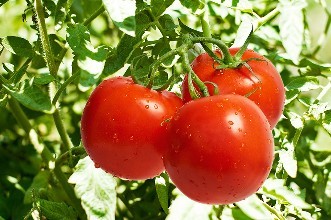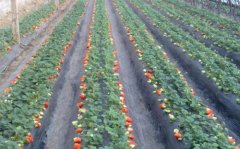Tomato diseases and insect pests: control of tomato rot and tomato stem rot
[control of tomato wilt]
Tomato Fusarium wilt is caused by Fusarium oxysporum f. Sp. Caused by Lycopersici. When you get sick at the seedling stage, you will die quickly. It generally occurs in the middle and later stage, the first leaf vein permeation and upper growth, gradually yellowing and withering upward from the lower leaf, the initial symptoms often appear only on one side of the plant, and then the petiole hangs down and the whole plant dies (figure 1). The vascular bundles can be seen browning (figure 2), but the white bacterial sludge without bacterial wilt can be used as the difference between the two diseases. Fusarium wilt of tomato is another thorny disease in tomato cultivation in Taitung. This disease is a soil-borne disease, which is not easy to control, and has a tendency to spread day by day.

After the thick membrane spore of this strain germinated, the germination tube invaded directly from the root tip of tomato or from the wound. The mycelium grows up and down when it encounters a catheter, and it can also flow upward with water. Before the diseased plant showed signs of withering, a slight brown color could be found on the wall of the catheter, followed by browning around the catheter, leaf withering and death, and finally the rest of the diseased plant withered. At this point, the pathogen develops to the surface of the plant and produces meristems, which are spread by wind or water. When the soil moisture is high and the temperature is low, the pathogen can develop to the fruit, and the seed carries the pathogen, so the disease can be transmitted not only by soil but also by seed.
The bacteria was most suitable for growth at soil pH 7-8, and the optimum soil temperature was 28 ℃. When the soil pH was above 33 ℃ and below 21 ℃, the occurrence of the disease was inhibited, that is, it mainly occurred in the middle and later stages of growth.
The officially recommended control agents for this disease are being tested, and the appropriate cultivation and management methods are still used as the control strategy at present, the main points are as follows:
I.
Plant disease-resistant grafted seedlings and clean seedlings.
II.
The disease is mainly spread by soil. When diseased plants are found, the surrounding plants should be removed immediately, and irrigation should be reduced as far as possible to avoid transmission.
3.
Adjust the pH value of soil to 6-7.
- Prev

Strawberry planting techniques and strawberry cultivation methods, strawberry cultivation and management techniques
(1) the combination of environmental selection and relevant measures, the implementation of soil rotation, the implementation of soil diagnostic analysis, soil improvement, no pollution of soil, air and water sources. (2) weed control methods to weed control by artificial or mechanical ploughing and weeding without the use of chemical herbicides. Adopt a cover or wheel
- Next

Why are there bugs in grapefruit? Harmful symptoms and rusty symptoms of grapefruit thrips
The fragrant season of grapefruit flowers is also the season with high incidence of diseases and insect pests. At this time, the prevention and control of thrips and rust should be strengthened to ensure the fruit quality of grapefruit. Otherwise, grapefruit will have a great loss, so we should do a good job in this area. Pomelo is in full bloom, and its flowering period is long.
Related
- A one-day flower show brings 130 million yuan in orders! Nanhai, this Phalaenopsis exhibition is amazing
- What do the flower language and meaning of Lutheran tree mean? Precautions for planting Lutheran tree
- Encounter Chaoshan Kongfu tea, not without this cup of Phoenix single clump
- The durian market in Vietnam and Thailand is flooded. The price of imported durian has plummeted by 30-40% in a month.
- Shanghai solved the problem of local vegetable supply by planting 80,000 mu of green leafy vegetables.
- Wageningen University has become the best agricultural university in the world for the seventh time in a row.
- The strongest export season of South African grapes is full of challenges, with exports to Russia falling sharply by 21%.
- Sri Lanka is on the verge of bankruptcy, "Tea for debt" Organic Agriculture Revolution aggravates the Food crisis?
- Turning waste into earthworm manure and worm manure into organic fertilizer-A new choice for auxiliary farming
- Organic rice growers shoulder the responsibility of nurturing agricultural talents! Yinchuan Sustainable Farm with Organic Life Camp

